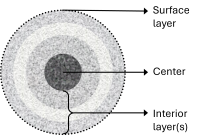About the Lab
Originally opened in 1981, the G.V. Ling Urinary Stone Analysis Laboratory was an early pioneer and specialist in companion animal urinary stones, which can differ greatly in both appearance and mineral composition from human stones. Stone analysis provides key stone compositional information that can be critical for establishing why the stones originally formed and what management techniques could prevent their future recurrence. Through a holistic investigation of the relationship between diet, environmental and patient factors, and urinary tract condition, we aim to advance the science of urinary tract health.
All analyses and veterinary consultations are completely free of charge, thanks to generous support from Purina PetCare. Currently the stone lab provides urinary stone analysis services for dogs and cats.
Submitting Samples
To submit a sample, fill out the submission form and send to us via the shipping instructions (click below). We recommend opening the form (pdf) link in a new window tab.
Shipping Instructions
All stones should be submitted clean and dry in a labelled and non-breakable container. Ideally all removed stones should be submitted for analysis – if this is not possible, a representative sample of shapes and sizes should be sent. Samples as small as 1mm can be analyzed.
If stones are clean and dry, they may be stored and shipped at room temperature. Samples should NOT be stored in formalin or any other liquid. Inappropriate storage or submission can delay stone analysis or lead to ambiguous results.
Send completed form and sample to:
UC Davis VMTH
Central Laboratory Receiving, Room 1033, 1 Garrod Dr
Davis, CA 95616
For quicker results, please send the specimens via Fed Ex or expedited shipping. We usually have reports available within 2-5 business days of receiving the sample.
For questions, contact us:
530-760-9209 | stonelab@ucdavis.edu
530-752-VMTH (8684) | UCDVetClinicalLabs@ucdavis.edu
About Urinary Stones

Urinary calculi, or uroliths, are mineral deposits found within the urinary tract. The composition of these stones can vary widely according to etiology – not only can there be multiple urolith types present within the same animal, but a single stone may also differ in composition between the surface layer, the interior layers (of which there may be multiple) and the center nidus of the urolith. Alternatively, a urolith may be completely homogenous, where the entirety of the stone is of a single mineral composition and there are no noteworthy distinctions between parts of the stone.
Our Diagnostic Methods
The stones are first examined under a dissecting microscope for any distinguishing characteristics on the surface or cross-sectional textures. Afterwards crystals are inspected with a polarizing microscope and identified by the oil immersion method of optical crystallography, based on features such as refractive index, birefringence, and crystal shape. When necessary, additional analysis of the uroliths is conducted utilizing Fourier transform infrared spectroscopy (FTIR) and other specialized technologies such as X-ray diffraction.
Urinary stone analysis is typically completed within one week, allowing ample time to create a management plan for when patients are seen for post op checkups.
Lab Personnel

Jodi L. Westropp DVM, PhD, DACVIM
Director

Samantha Barnum, MS
PCR Lab Supervisor

Angelica Kallenberg
Staff Researcher
Our Research
Stone analysis at the G.V. Ling Stone Analysis Laboratory has resulted in numerous presentations as well as peer reviewed manuscripts. Not only have these been in the form of retrospective studies that examine breed- or population-level differences or chronological trends, but also technical notes on stone analysis that further the field.
All stones submitted to the VMTH Clinical Diagnostic Laboratories may be used for VMTH teaching and research purposes consistent with the mission of the University. Please contact the Stone Lab directly at stonelab@ucdavis.edu regarding potential collaborative studies.
- Clinical Trials
- • Dogs with Calcium Oxalate Stones
• Dogs with Urinary Tract Infections - Select Publications
2018 Paßlack N, Zentek J, Larsen JA, Westropp JL, Fascetti AJ Impact of hyperlipidaemia on intermediary metabolism, faecal microbial metabolites and urinary characteristics of lipoprotein lipase deficient vs. normal cats J Anim Physiol Anim Nutr (Berl),
2018 Segev G, Sykes JE, Klumpp DJ, Schaeffer AJ, Antaki EM, Byrne BA, Yaggie RE, Westropp JL Evaluation of the Live Biotherapeutic Product, Asymptomatic Bacteriuria Escherichia coli 2-12, in Healthy Dogs and Dogs with Clinical Recurrent UTI J Vet Intern Med,
2017 Merkel LK, Lulich J, Polzin D, Ober C, Westropp JL, Sykes J Clinicopathologic and Microbiologic Findings Associated with Emphysematous Cystitis in 27 Dogs JAAHA. (pdf)
2017 Westropp JL, Larsen JA, Johnson EG, Bannasch D, Fascitti AJ, Biourge V, Queau Y Evaluation of dogs with genetic hyperuricosuria and urate urolithiasis consuming a purine restricted diet: A pilot study BMC Vet Res,
2017 Kent MS, Zwingenberger A, Westropp JL, Barrett LE, Durbin-Johnson BP, Ghosh P, Vinall RL MicroRNA profiling of dogs with transitional cell carcinoma of the bladder using blood and urine samples BMC Vet Res. (pdf)
2016 Mellema M, Stoller M, Queau Y, ho SP, Chi T, Larsen JA, Passiack N, Fascetti AJ, Mohr C, Westropp JL Nanoparticle tracking analysis for the enumeration and characterization of mineralo-organic nanoparticles in feline urine PLoS One.
2016 Lulich JP, Berent AC, Adams LG, Westropp JL, Bartges JW, Osborne CA ACVIM Small Animal Consensus Recommendations on the treatment and prevention of uroliths in dogs and cats J Vet Intern Med. - (pdf)
2016 Palm CA, Segev G, Cowgill L, LeRoy B, Kowalkowski KL, Kanakubo K, Westropp JLUrinary neutrophil gelatinase-associated lipocalin as a marker for acute kidney injury identification and recovery in dogs with Gentamicin-induced nephrotoxicity J Vet Int Med.
2015 Keller KA, Hawkins MG, Weber SEP, Ruby AL, Sanchez-Migallon Guzman D, Westropp JL Diagnosis and treatment of urolothiasis in client owned chelonians: 40 cases (1987-2012) J Am Vet Med Assoc.
2015 Safra N, Hayward LJ, Aguilar M, Sacks BN, Westropp JL, Mohr CF, Mellersh CS, Bannasch DL DNA sequence variants in the five prime untranslated region of the cyclooxygenase-2 gene are commonly found in healthy dogs and gray wolves PLoS One.
Low WW, Uhl JM, Kass PH, Ruby AL, Westropp JL. Evaluation of trends in urolith composition and characteristics of dogs with urolithiasis: 25,499 cases (1985-2006). JAVMA 15(236): 193-200, 2010. (pdf)
Cannon AB, Westropp JL, Ruby AL, Kass PH. Evaluation of trends in urolith composition in cats: 5,230 cases (1985-2004). JAVMA, 231(4): 570-6, 2007. (pdf)
Westropp JL, Ruby AL, Bailiff NL, Kyles AE, Ling GV. Dried solidified blood calculi in the urinary tract of cats. JVIM, 20(4): 828-34, 2006. (pdf)
ACVIM consensus statement Recommendations for Urolithiasis. (pdf)
Our Mission
The G. V. Ling Urinary Stone Analysis Laboratory is dedicated to provide reliable, accurate and prompt layer by layer stone analyses for our clients. We strive to maintain the most current scientific techniques available for these analyses for clinical and research endeavors. Furthermore, we are committed to helping veterinarians manage their patients. We use science, technology and education as our tools.
- FAQs
Q: Can any veterinarian or animal laboratory send samples to the G.V. Ling Urinary Stone Analysis Laboratory at Davis?
A: Yes, we receive samples from veterinary practices and laboratories from all over the United States as well as several foreign countries.Q: How much is a stone analysis at UC Davis?
A: Stone analysis is free of charge, made possible by generous support from Purina Petcare.Q: How long will it take for me to obtain the results?
A: We have most stone analysis reports prepared within 2 to 5 days of receiving the sample.Q: Can any pet owners submit stones they have obtained from their pets directly to the G.V. Ling Urinary Stone Analysis Laboratory?
A: No, samples must come from a veterinary practice or animal laboratory. By working with your veterinarian, we will be able to help you both tailor a proper stone prevention strategy for your pet.Q: Do I need to put the stone in formalin in order to send it to you?
A: No. Stones should be sent clean and dry. While formalin should not hurt most stones, exposure to formalin can affect struvite stones and can change the surface crystals from struvite to newberyite. Additionally, the formalin will need to be removed prior to analysis, delaying results, and shipping a stone in formalin requires extra care and packaging to ensure safe shipping.Q: Does your laboratory analyze stones removed from human beings?
A: No. We are not licensed to analyze stones from humans.Q: Should I send all the stones I have removed from the animal?
A: The composition can vary from stone to stone, so at minimum a representative sample of shapes and sizes should be sent.
Contact
530-760-9209 | stonelab@ucdavis.edu
530-752-VMTH (8684) | UCDVetClinicalLabs@ucdavis.edu
Send samples* with a completed sample form to:
UC Davis VMTH
Central Laboratory Receiving, Room 1033, 1 Garrod Dr.
Davis, CA 95616
*We recommend mailing the clean and dry sample via FedEx or UPS in a labelled and non-breakable container.

